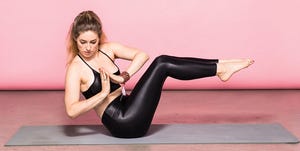I’ve never taken a hot yoga class, but I’ve always had an easy time imagining what it might be like—thanks, in part, to my roommate (a walking ad for the workout), and also because the A/C in our apartment broke once. After sweating through my sheets, I decided hot yoga belonged on the back burner.
But in a recent effort to turn up the heat on my workouts (pun intended), I’ve been thinking about giving it a go. Is it legit, though? Do 100-degree temperatures actually make a difference? Or am I just going to end up slipping on my sweat for no reason?
Before risking a fainting spell mid-downward dog, I checked in with Jorianne Numbers, MS, an exercise physiologist at Northwestern University, who walked me through the benefits and downsides of hot yoga.
The Benefits Of Hot Yoga
The Benefits Of Hot Yoga
It makes you more flexible.
“Temperatures are usually up to 105 degrees Fahrenheit,” says Numbers, and the humidity is way up there, too, at around 40 to 60 percent.
The warmer room will make it easier for your muscles to stretch. The steamy temps “allow you to increase their range of motion and stretch deeper within each pose,” since heat makes muscles more pliable, says Numbers. Unlike stretching it out in a standard cool yoga studio, the heat will have you feeling like a pro and extending further than you thought you could.
It’s intense.
As an added challenge, the heat in a hot yoga studio will make your heart pump way faster, because it needs to push more blood toward the skin in an effort to keep you feeling cool, says Numbers. And more heart-pumping means a better cardio workout than you’d get doing the same yoga sequence in a cooler setting.
It helps kick stress to the curb.
Okay, yeah, regular yoga practiced in air conditioning can help you chill out, but the heat’s an added bonus. “Usually, hot yoga makes you focus on your breathing more,” since it’s sweltering in those rooms, says Numbers. And breathing deeper is key to relaxation and stress-relief.
It ups your lung capacity.
While you might think a stifling room makes it harder to breathe, the breathing exercises in hot yoga can actually help train your lungs to retain more air, says Numbers. Deeper breaths force them to expand more than usual, which allows for more oxygen to enter the blood stream and get to the other organs.

It burns major calories.
“Any kind of movement that increases your heart rate will help burn calories and promote weight loss,” says Numbers. And hot yoga is a pretty good calorie-torcher. Even though you’re not running and jumping around, again, that hot room gets the heart going. One study from the journal Medicine & Science in Sports & Exercise found women burned an average of 333 calories during 90-minute slow-moving, heated yoga session. Add a fast-moving Vinyasa practice to that mix (which made the Women’s Health list of top calorie-burning exercises) and you’ll really feel the, well, burn.
The Downsides Of Hot Yoga
The Downsides Of Hot Yoga
You risk heat exhaustion.
Even if you passed your last check-up with flying colors, if you can’t stand the heat in a hot yoga studio, your “blood pressure may drop, making you feel dizzy or nauseated,” says Numbers.
And this sensation can totally sneak up on you. So while you might feel great—all purified and sweaty—for the first 30 minutes of class, it’s important to take note of how you’re feeling throughout the flow, especially if you’re a hot yoga newbie.
You might become dehydrated.
You’re going to sweat out a lot of water during a hot yoga session, which means you need to drink ample water before and during class to compensate. “The hotter room temperature can cause fainting and muscle cramping,” according to Numbers, as well as vomiting. But staying adequately hydrated can help prevent these issues.
You might injure yourself.
“Due to the increased flexibility of the muscles and the warmer temperatures, it’s possible to overdo it,” says Numbers. “You may push yourself too far in a pose or stretch and you may not actually feel that until after class.”



It’s not for everybody.
If you’re pregnant, have a heart condition, or suffer from a cardiovascular disease, you should probably look for a different form of exercise. And if you do fall into any of these camps, at least be sure to talk to your doctor before attempting yoga that involves heat, advises Numbers.
Or, honestly, if you just don’t feel comfortable in a super heated, humid room, this probably isn’t the best workout for you—no matter how many of your friends swear by it.
How To Prepare Your Body For Hot Yoga
Numbers is all about hydration. Up to 24 hours before you take a hot yoga class, load up on your fluids, especially ones with electrolytes. And if you eat before yoga, leave a two-hour window between the meal and the class for proper digestion.
“You also want to wear clothes that you’re comfortable sweating in such as a sweat-wicking or breathable fabric, because you’re going to be sweating a lot.”
Lastly, Numbers says to listen to your body. If you feel dizzy, stop and load up on water and electrolytes.
Bottom line: Hot yoga is a perfectly safe form of exercise for most people. Just follow pre-class safety measures, pay attention to your body, and be sure to talk to your doctor if you have any concerns.
Source: Read Full Article
